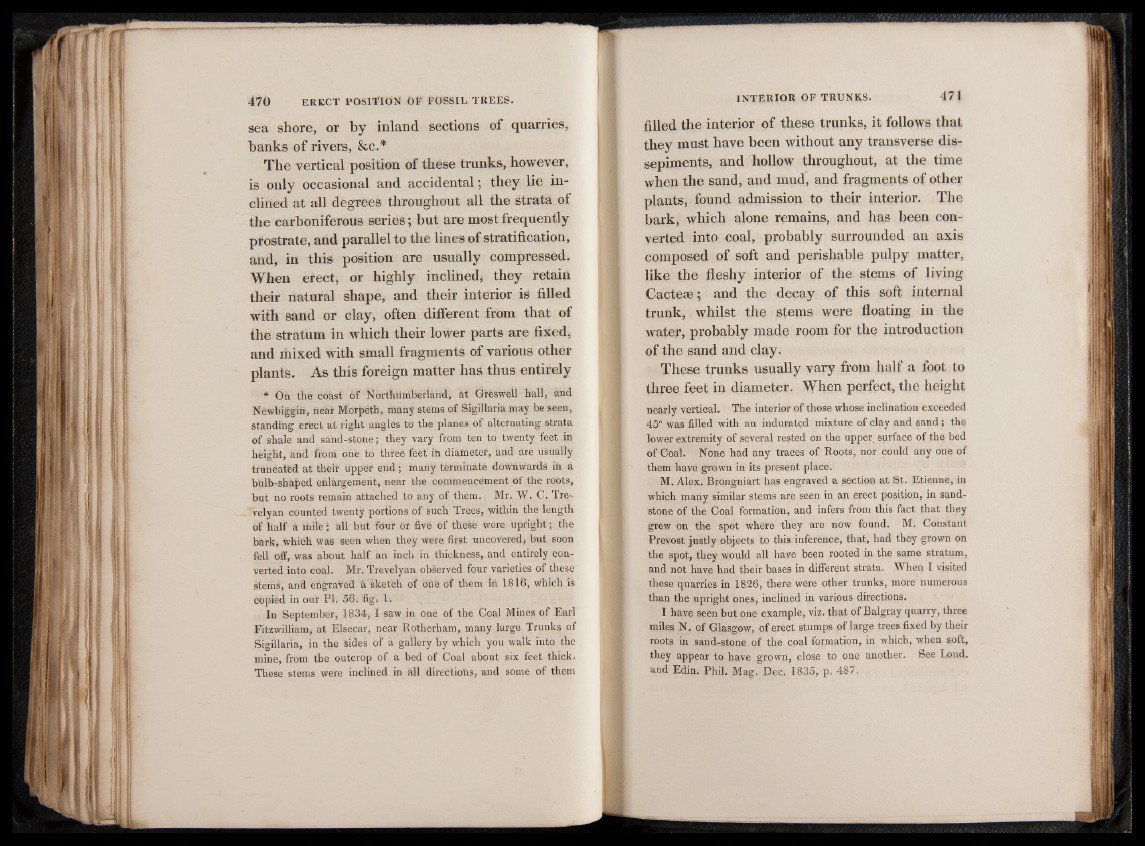
sea shore, or b y inland sections o f quarries,
banks o f rivers, &c.*
The vertical position of these trunks, however,
is only occasional and accid en ta l; they lie inclined
at all degrees throughout all the strata of
the carboniferous s e r ie s; but are most frequently
prostrate, and parallel to the lines o f stratification,
and, in this position are usually compressed.
When erect, or highly inclined, they retain
their natural shape, and their interior is filled
with sand or clay, often different from that o f
the stratum in which their lower parts are fixed,
and mixed with small fragments of various other
plants. A s this foreign matter has thus entirely
* On the cohst of Northumberland, at Gfeswell hall, and
Newbiggin, near Morpeth, many stems of Sigillaria may be seen,
standing erect at right angles to the planes of alternating strata
of shale and sand-stone; they vary from ten to twenty feet in
height, and from one to three feet in diameter, and are Usually
truncated at their Upper end; many terminate downwards in a
bulb-shaped enlargement, near the commencement df the roots,
but no roots remain attached to any of them. Mr. W. C. Trevelyan
counted twenty portions of such Trees, within the length
of half a mile; fill but four or five of these were Upright; the
bark, which Was seen when they Were first uncovered, but soon
fell off, was about half an inch in thickness, and entirely converted
into coal. Mr. Trevelyan observed four varieties of these
stems, and engraved a Sketch of one of them in 1816, Which is
copied in our PL 56; fig; 1;
In September, 1834, I saw in one of the Coal Mines of Earl
Fitzwilliam, at Elseear, near Rotherham, many large Trunks of
Sigillaria, in the sides of a gallery by which you walk into the
mine, from the outcrop of a bed of Coal about six feet thick.
These stems were inclined in all directions, and some of them
filled the interior o f these trunks, it follows that
they must have been without any transverse dissepiments,
and hollow throughout, at the time
when the sand, and mud, and fragments o f other
plants, found admission to their interior. The
bark, which alone remains, and has been converted
into coal, probably surrounded an axis
composed o f soft and perishable pulpy matter,
like the fleshy interior o f the stems o f living
Cactese; and the decay o f this soft internal
trunk, whilst the stems were floating in the
water, probably made room for the introduction
o f the sand and clay.
These trunks usually vary from half a foot to
three feet in diameter. When perfect, the height
nearly vertical. The interior of those whose inclination exceeded
45° was filled with an indurated mixture of clay and sand; the
lower extremity of several rested on the upper, surface of the bed
of Coal. None had any traces of Roots, nor could any one of
them have grown in its present place.
M. Alex. Brongniart has engraved a section at St. Etienne, in
which many similar stems are seen in an erect position, in sandstone
of the Coal formation, and infers from this fact that they
grew on the spot where they are now found. M. Constant
Prevost justly objects to this inference, that, had they grown on
the spot, they would all have been rooted in the same stratum,
and not have had their bases in different strata. When I visited
these quarries in 1826, there were other trunks, more numerous
than the upright ones, inclined in various directions.
I have seen but one example, viz. that of Balgray quarry, three
miles N. of Glasgow, of erect stumps of large trees fixed by their
roots in sand-stone of the coal formation, in which, when soft,
they appear to have grown, close to one another. See Lond.
and Edin. Phil. Mag. Dec. 1835, p. 487.